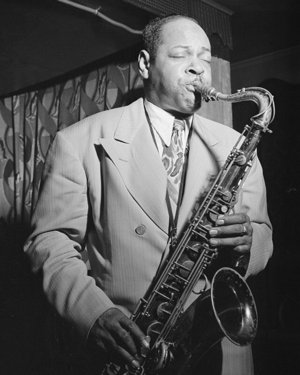Coleman Hawkins

-
Birth Name
Coleman Randolph Hawkins -
Born
November 2, 1904
St. Joseph, Missouri -
Died
May 19, 1969 (age 64)
New York, New York -
Featured Vocalists
Thelma Carpenter
A master of the tenor sax, Coleman Hawkins was one of the most important jazz figures of the 20th Century. His unusual sense of improvisation allowed him to reach heights of expressionism that few other artists of his era had reached. Hawkins’ solo on his 1939 version of “Body and Soul” is considered a masterpiece and a true classic of American music. Nicknamed both “Hawk” and “Bean,” he was also one of the few musicians of the golden jazz age to make the transition to be-bop.
Hawkins studied piano and cello as a child. He took up the tenor saxophone at age nine and was performing for school dances by the time he was twelve. Growing up in Chicago and attending college in Topeka, Kansas, Hawkins wound up in Kansas City in 1921 playing for a theater orchestra. Mamie Smith heard him perform one evening in 1922 and offered him a spot in her Jazz Hounds. Hawkins traveled with the group to New York, where he made his first recordings, then across country to California and back to New York again.
Hawkins left the Jazz Hounds in mid-1923 and worked freelance around the New York area until joining Fletcher Henderson in 1924. He had previously worked with the bandleader during his earlier stay in the city. Hawkins stayed with Henderson for ten years. During this period the band was creating the sound that eventually became swing, and Hawkins became an integral part of that development.
Hawkins left Henderson in 1934 when a planned tour of England fell through, feeling it time to move on. He contacted English bandleader Jack Hylton, who brought him to England to play with his orchestra. Hawkins stayed behind in continental Europe after an extensive Hylton tour there ended, and for the next four years he played and recorded with many European and expatriate American jazz greats, including a now famous 1937 session with Benny Carter and Django Reinhardt.
Hawkins returned to England in March 1939 and to New York in July of that same year. American audiences had heard little of his European recordings and were generally unaware of his talent. He formed a nine-piece outfit with which he recorded his famous version of “Body and Soul.” The song became a huge hit, and Hawkins was voted Tenor Sax of the Year by Downbeat magazine.
Big Band Years and Bebop
With that success under his belt, Hawkins decided to form his own big band. He soon lost interest in the orchestra, though, and was often absent from it, preferring to work with smaller groups and develop his interest in bop. The orchestra continued as a unit into the mid-1940s, settling into Kelly’s Stables on 52nd Street in New York. Thelma Carpenter was vocalist from late 1939 to early 1942.
In 1944, Hawkins hired Thelonious Monk and Dizzy Gillespie as part of his quartet. He also worked with a young Miles Davis. From 1946 on, Hawkins’ was dividing his time between working with his small groups in New York, touring with Jazz at the Philharmonic, and touring in Europe. By 1950, the innovations of younger bop musicians had made Hawkins’ style seem outdated. In the early 1950s, he made a more complete transition to be-bop, working with Roy Eldridge throughout most of the decade. By the late 1950s, he was in demand once again, playing numerous jazz festivals and recording with such artists as Thelonious Monk, Max Roach, John Coltrane, and Duke Ellington.
Hawkins battled alcoholism throughout his life, spending his last two years struggling with constant illness. He passed away in 1969 from liver disease.
Sources
- Simon, George T. The Big Bands. 4th ed. New York: Schirmer, 1981.
- “Hawkins Gets 9-Piece Jam Outfit Going.” Down Beat 15 Oct. 1939: 5.
- “Record Reviews: Coleman Hawkins.” Down Beat 1 Dec. 1939: 14.
- “Where Is?” Down Beat 15 Aug. 1942: 9.
- “Single Slants: Thelma Carpenter.” Down Beat 1 Oct. 1942: 20.